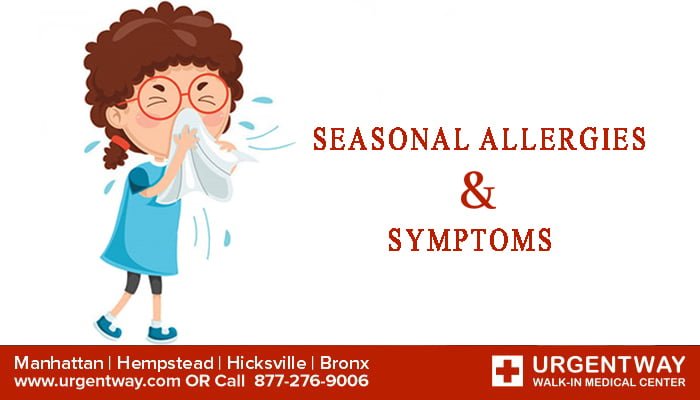What are seasonal allergies?
Seasonal allergies, sometimes called “hay fever” or seasonal allergic rhinitis, are allergy symptoms that happen during certain times of the year, usually when outdoor molds release their spores, and trees, grasses, and weeds release tiny pollen particles into the air to fertilize other plants. The immune systems of people who are allergic to mold spores or pollen treat these particles as invaders and release chemicals, including histamine, into the bloodstream to defend against them. The release of these chemicals causes allergy symptoms. One or more kinds of pollen or mold may cause allergic reactions in people. The type of allergen may be determined when symptoms happen. Seasonal allergies may develop at any age, although they typically begin around the age of ten and peak in the early twenties, with symptoms frequently dissipating later in life. Sneezing, itchy nose, nasal congestion, clear, runny nose, and coughing are some of the most typical symptoms of seasonal allergies. In addition to these symptoms, those who experience wheezing and shortness of breath may have allergens that cause asthma.
Symptoms of seasonal allergies
Seasonal allergies can be if you sneeze and cough at particular seasons of the year. However, allergies aren’t something you have to put up with regularly. Symptoms of seasonal allergies range from mild to severe.
Most common symptoms of seasonal allergies
The most common symptoms of seasonal allergies include:
- Sneezing
- Runny or stuffy nose
- Watery and itchy eyes
- Itchy sinuses, throat, or ear canals
- Ear congestion
- Postnasal drainage
- Trouble in sleeping
Less common symptoms of seasonal allergies
The less common symptoms of seasonal allergies include:
- Headache
- Shortness of breath
- Wheezing
- Coughing
Many individuals who suffer from seasonal allergies also have asthma. Seasonal allergens may cause an asthma attack if you have both hay fever and asthma. Avoidance of allergens that cause symptoms for you is the best option for seasonal allergies and year-round allergic rhinitis. Seasonal allergy symptoms may also be treated with medication.
Most vulnerable body parts
The most vulnerable body parts are the nose, ear, sinuses, and eyes, so the symptoms can be noticed from them as given below:
i. Nose-related symptoms
Seasonal allergies can make the nose, the roof of the mouth, the back of the throat, and the eyes itch. Itching may start gradually or abruptly. The nose runs, producing a clear watery discharge, and may become stuffed up. In children, a stuffy nose may lead to an ear infection. The lining of the nose may become swollen and bluish-red.
ii. Sinuses related symptoms
The sinuses may also become stuffed up, causing headaches and occasionally sinus infections (sinusitis ). Sneezing is common.
iii. Eyes related symptoms
The eyes may water, sometimes profusely, and itch. The whites of the eyes may become red, and the eyelids may become red and swollen. Wearing contact lenses can irritate the eyes further.
Seasonal allergies related triggers
When your immune system misidentifies a usually neutral chemical as a harmful intruder, an allergy develops. The immune system then develops antibodies that keep the body on alert for the allergen in consideration. When you’re exposed to the allergen again, these antibodies may produce a variety of immune system chemicals that trigger allergy symptoms, such as histamine. While grass, pollen, and mold are often associated with “seasonal allergies,” other triggers are strongly linked to specific seasons. Among them:
- Smoke (campfires in summer, fireplaces in winter)
- Insect bites and stings (usually in spring and summer)
- Chlorine in indoor and outdoor swimming pools
- Candy ingredients (Halloween, Christmas, Valentine’s Day, Easter)
- Pine trees and wreaths (Thanksgiving to Christmas)
Diagnosis
Seasonal allergies are simple to identify because the same set of symptoms appears each year after exposure to an allergen. If you suspect you have allergies, see your doctor. The doctor will inquire about your symptoms in the physical examination and will diagnose an allergy depending upon your response. If not, the doctor may send you to an allergist for allergy skin testing or blood tests. To diagnose an allergy, allergists usually do skin tests in one of two ways:
- A drop of purified liquid allergen is applied directly to the skin and pricked up the area with a tiny pricking instrument.
- An allergen is injected just under the skin in a low amount. This test hurts a bit, but it’s not too bad. The test is positive if a lump surrounded by a reddish region develops at the injection site after approximately 15 minutes.
Treatment of seasonal allergies
When you can’t avoid your allergens, other treatments are available, including:
- Over-the-counter decongestants and antihistamines, such as cetirizine (Zyrtec), and combination medications containing acetaminophen, diphenhydramine, and phenylephrine.
- Prescription medications, such as steroid nasal sprays.
- In severe cases, your doctor may recommend allergy shots. They’re a type of immunotherapy that can help desensitize your immune system to allergens.
Alternative treatments
Few studies have been done on alternative treatments for Seasonal allergies. Some people believe the following alternative treatments may provide relief:
- Quercetin, is a flavonoid that gives fruits and vegetable color.
- Lactobacillus acidophilus, is the “friendly” bacteria found in yogurt.
- Spirulina, is a type of blue-green algae.
- Vitamin C, which has some antihistamine properties
Avoidance is the best option
Take precautions to stay away from seasonal allergens. Instead of ceiling fans, use an air conditioner with a HEPA filter to cool your house in the summer. Check your local weather network for pollen forecasts, and try to stay indoors when pollen counts are high. At times of the year when your hay fever is active:
- keep your windows shut
- limit your time outdoors
- consider wearing a dust mask when you’re outside, especially on windy days
- It’s also important to avoid cigarette smoke, which can aggravate hay fever symptoms.
Seasonal allergies may cause a lot of discomfort. There are some common symptoms to diagnose seasonal allergies. Consult your doctor if you think you have seasonal allergies. They can assist you in diagnosing the origin of your symptoms and developing a treatment strategy. They will almost certainly advise you to avoid your allergy triggers. They may also suggest over-the-counter or prescription medications.


